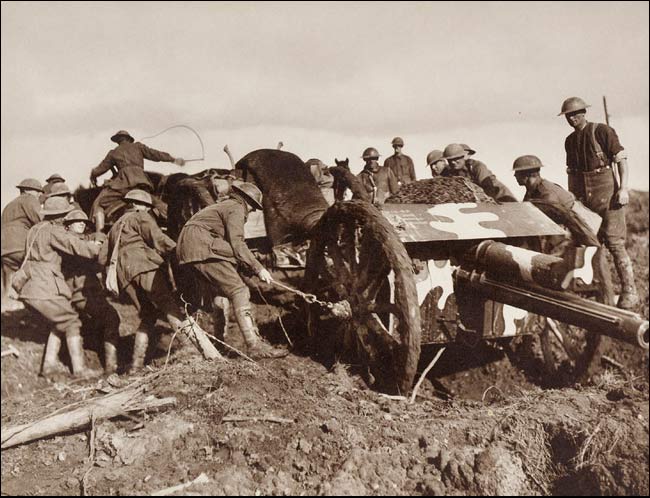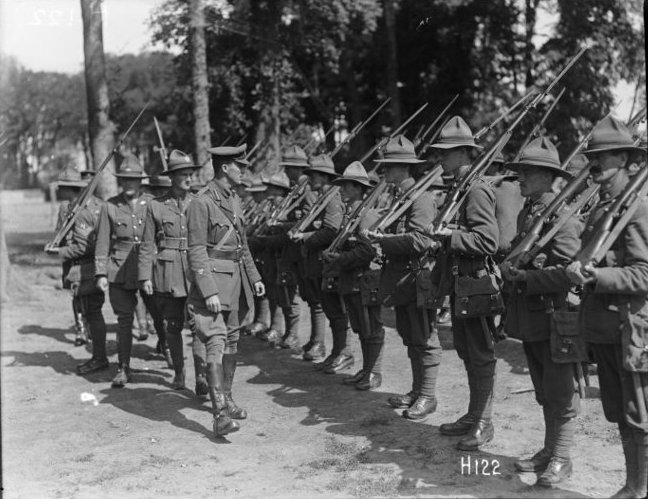|
2nd Infantry Brigade (New Zealand)
The 2nd Infantry Brigade was a formation of the New Zealand Military Forces raised for service abroad with the New Zealand Expeditionary Force during the First World War. As part of the New Zealand Division, it participated in several major battles on the Western Front from 1916 to 1918 before being disbanded in 1919. There was also a 2nd Infantry Brigade in the New Zealand Territorial Force that existed from 1924 to 1964. History First World War It was formed in Egypt in 1916 for service with the New Zealand Division on the Western Front. Its original commander was Brigadier General William Garnett Braithwaite, a British Army officer on secondment to the New Zealand Military Forces. Upon formation, the brigade consisted of four infantry battalions: the 2nd Battalion, Auckland Regiment; the 2nd Battalion, Wellington Regiment; the 2nd Battalion, Canterbury Regiment; and the 2nd Battalion, Otago Regiment. This was later changed, though, when several battalions were swapped between ... [...More Info...] [...Related Items...] OR: [Wikipedia] [Google] [Baidu] |
1st Infantry Brigade (New Zealand)
The 1st Brigade is currently the largest unit of the New Zealand Army, and contains most of the army's deployable units. The brigade was formed on 13 December 2011 by amalgamating the 2nd Land Force Group and 3rd Land Force Group. Its establishment formed part of the 'Army 2015' package of reforms. Previous 1st Brigades in the New Zealand Army have included a brigade in the Middle East and France, 1916–19, a home defence formation active during the Second World War (part of the North Island home defence 1st Division), and a 1 Brigade / Integrated Expansion Force formed to direct three Territorial Force-formed battalions in the 1970s and 1980s. History First World War The 1st Brigade came into being in Egypt in early 1916, when the New Zealand and Australian Division was re-organised in the wake of the Gallipoli Campaign, and the New Zealand Division was formed. Under the command of Brigadier General Harry Fulton, the brigade initially consisted of four infantry battalions, ... [...More Info...] [...Related Items...] OR: [Wikipedia] [Google] [Baidu] |
Military Units And Formations Established In 1916
A military, also known collectively as armed forces, is a heavily armed, highly organized force primarily intended for warfare. It is typically authorized and maintained by a sovereign state, with its members identifiable by their distinct military uniform. It may consist of one or more military branches such as an army, navy, air force, space force, marines, or coast guard. The main task of the military is usually defined as defence of the state and its interests against external armed threats. In broad usage, the terms ''armed forces'' and ''military'' are often treated as synonymous, although in technical usage a distinction is sometimes made in which a country's armed forces may include both its military and other paramilitary forces. There are various forms of irregular military forces, not belonging to a recognized state; though they share many attributes with regular military forces, they are less often referred to as simply ''military''. A nation's military may f ... [...More Info...] [...Related Items...] OR: [Wikipedia] [Google] [Baidu] |
Official History Of New Zealand's Effort In The Great War
The ''Official History of New Zealand's Effort in the Great War'' is a four-volume 'Popular History' series which covered the New Zealand involvement in the First World War. Aimed at presenting the efforts of the New Zealand Military Forces during the war to the general public, the series was published during the period 1919 to 1923 under the stewardship of Fred Waite. Although the primary source of information on the New Zealand military contribution to the First World War for many years, it was recognised as an insufficient tribute to New Zealand soldiers who served during the conflict. Background As early as 1915, it was recognised by the New Zealand Government that an official history would be produced to document the contributions of the New Zealand Expeditionary Force (NZEF) to the First World War. The official war correspondent, Malcolm Ross, was tasked with collecting the historical material that would be required. Ross, a trained journalist who had reported on the seizu ... [...More Info...] [...Related Items...] OR: [Wikipedia] [Google] [Baidu] |
1st Division (New Zealand)
The 1st Division was one of three New Zealand Army home defence divisions formed during World War II. The unit was established on 1 November 1941 and was responsible for protecting the northern region of New Zealand's North Island from invasion. The 1st Division was placed on alert during the early months of the Pacific War, but no threat developed. The division was greatly reduced in size during 1943 and was disbanded on 1 April 1944. History As part of the preparations for the possible outbreak of war in the Pacific, the defensive forces stationed in New Zealand were expanded in late 1941. On 1 November, three new brigade headquarters were raised (taking the total in the New Zealand Military Forces, as the New Zealand Army was then known, to seven), and three divisional headquarters were established to coordinate the units located in the Northern, Central and Southern Military Districts.Cooke and Crawford (2011), p. 262 The division in the Northern Military District was designa ... [...More Info...] [...Related Items...] OR: [Wikipedia] [Google] [Baidu] |
4th Division (New Zealand)
The 4th Division was one of three home defence divisions of the New Zealand Military Forces formed during World War II. The unit was established on 1 November 1941 and was responsible for protecting the southern part of New Zealand's North Island from invasion. The division was greatly reduced in size during 1943 and was disbanded on 1 April 1944 without seeing combat. History As part of the preparations for the possible outbreak of war in the Pacific, the defensive forces stationed in New Zealand were expanded in late 1941. On 1 November, three new brigade headquarters were raised (taking the total in the New Zealand Military Forces, as the New Zealand Army was then known, to seven), and three divisional headquarters were established to coordinate the units located in the Northern, Central and Southern Military Districts.Cooke and Crawford (2011), p. 262 Upon formation, the division in the Central Military District comprised two brigade groups. The New Zealand Military Forces wer ... [...More Info...] [...Related Items...] OR: [Wikipedia] [Google] [Baidu] |
First Battle Of Passchendaele
The First Battle of Passchendaele took place on 12 October 1917 during the First World War, in the Ypres Salient in Belgium on the Western Front. The attack was part of the Third Battle of Ypres and was fought west of Passchendaele village. The British had planned to capture the ridges south and east of the city of Ypres as part of a strategy decided by the Allies at conferences in November 1916 and May 1917. Passchendaele lay on the last ridge east of Ypres, from the railway junction at Roulers, which was an important part of the supply system of the German 4th Army. After a dry spell in September, rains began on 3 October and by the Battle of Poelcappelle on 9 October much of the British field artillery opposite Passchendaele was out of action due to rain, mud and German artillery-fire. The remaining guns were either left in old positions and fired at the limit of their range or were operated from any flat ground near wooden roadways or from platforms, many of which were ... [...More Info...] [...Related Items...] OR: [Wikipedia] [Google] [Baidu] |
Battle Of Messines (1917)
The Battle of Messines (7–14 June 1917) was an attack by the British Second Army (General Sir Herbert Plumer), on the Western Front, near the village of Messines (now Mesen) in West Flanders, Belgium, during the First World War. The Nivelle Offensive in April and May had failed to achieve its more grandiose aims, had led to the 1917 French Army mutinies, demoralisation of French troops and confounded the Anglo-French strategy for 1917. The attack forced the Germans to move reserves to Flanders from the Arras and Aisne fronts, relieving pressure on the French. The British tactical objective was to capture the German defences on the ridge, which ran from Ploegsteert Wood (Plugstreet to the British) in the south, through Messines and Wytschaete to Mt Sorrel, depriving the German 4th Army (German Empire), 4th Army of the high ground. The ridge gave commanding views of the British defences and back areas of Ypres to the north, from which the British intended to conduct the North ... [...More Info...] [...Related Items...] OR: [Wikipedia] [Google] [Baidu] |
Battle Of Broodseinde
The Battle of Broodseinde was fought on 4 October 1917 near Ypres in Belgium, at the east end of the Gheluvelt plateau, by the British Second and Fifth armies against the German 4th Army. The battle was the most successful Allied attack of the Third Battle of Ypres. Using ''bite-and-hold'' tactics, with objectives limited to what could be held against German counter-attacks, the British devastated the German defence, which prompted a crisis among the German commanders and caused a severe loss of morale in the 4th Army. Preparations were made by the Germans for local withdrawals and planning began for a greater withdrawal, which would entail the abandonment by the Germans of the Belgian coast, one of the strategic aims of the Flanders offensive. After the period of unsettled but drier weather in September, heavy rain began again on 4 October and affected the remainder of the campaign, working more to the advantage of the German defenders, being pushed back on to far less damage ... [...More Info...] [...Related Items...] OR: [Wikipedia] [Google] [Baidu] |
4th Infantry Brigade (New Zealand)
The 4th Infantry Brigade was a formation of the New Zealand Military Forces, active in both the First and Second World Wars. It was initially raised in England in 1917 for service with the New Zealand Division on the Western Front during the First World War. It only fought in one major engagement, the Battle of Broodseinde, although it was in reserve for two other significant battles, the Battle of Messines and the First Battle of Passchendaele. The brigade was disbanded in early 1918 due to a reorganisation of the New Zealand Division. The brigade was resurrected for service in the Second World War as part of the 2nd New Zealand Division. It saw service during the Battle of Greece, the Battle of Crete and the North African campaign before being converted into the 4th New Zealand Armoured Brigade. First World War Formation The 4th Infantry Brigade was formed in response to a request made by the British War Office in February 1917 for a second New Zealand division, or failing ... [...More Info...] [...Related Items...] OR: [Wikipedia] [Google] [Baidu] |
Herbert Ernest Hart
Brigadier General Sir Herbert Ernest Hart, (13 October 1882 – 5 March 1968) was an officer in the New Zealand Military Forces who served during the Second Boer War and the First World War. He later served as the Administrator of Western Samoa and worked for the Imperial War Graves Commission. Hart volunteered for the Ninth New Zealand South African Contingent, which was raised for service in South Africa during the Second Boer War. By the time the contingent arrived in South Africa, the war was largely over. He saw extensive action during the First World War as a volunteer with the New Zealand Expeditionary Force, first at Gallipoli and then on the Western Front. By the end of the war, he had advanced in rank to brigadier general, commanding a number of brigades in the New Zealand Division. Trained as a lawyer before the war, Hart returned to New Zealand to resume his legal practice after his discharge from the New Zealand Expeditionary Force. He later served as Adminis ... [...More Info...] [...Related Items...] OR: [Wikipedia] [Google] [Baidu] |







